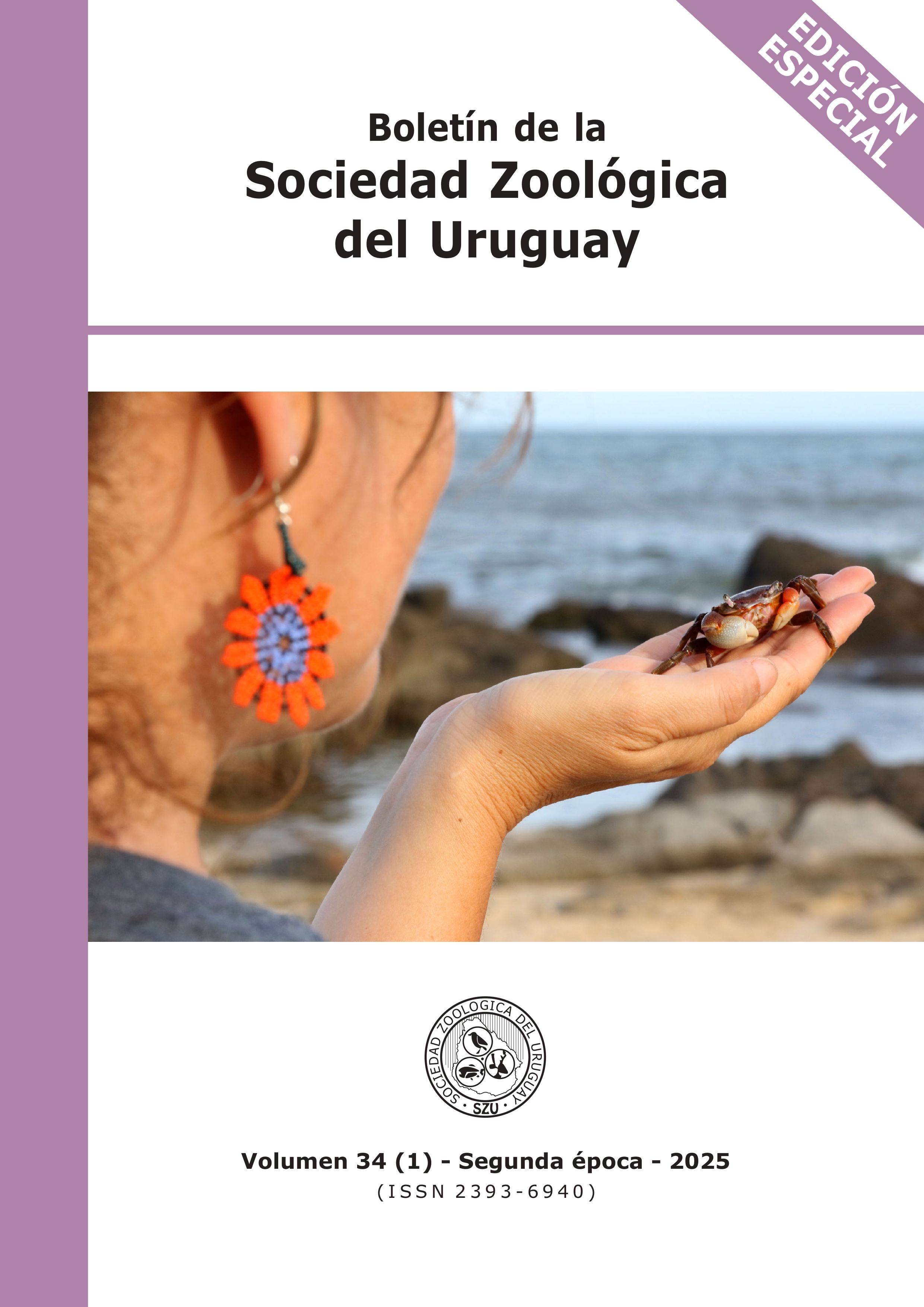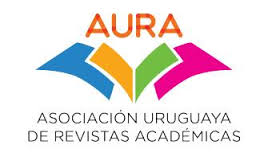FIRST CHECKLIST OF THE NON-ACARINE ARACHNIDS (CHELICERATA: ARACHNIDA) OF THE CHAPADA DIAMANTINA NATIONAL PARK, BRAZIL
DOI:
https://doi.org/10.26462/34.1.5Keywords:
Arachnids, Biodiverstity, Caatinga, BahiaAbstract
This work aims to provide regionalized information on the non-acarine arachnids inhabiting the Brazilian Chapada Diamantina National Park (PARNA-CD), and its surroundings, to support studies for protecting endemic species and preventing human accidents by these animals. We used registers of five arachnological collections covering 36 years, validated by the world catalogs of each order. We found 67 arachnid species from five orders, 42 families, in the six municipalities surrounding PARNA-CD. Araneae (54 species) and Scorpiones (ten species) were the most representative orders. We found no records of the other orders except for Pseudoscorpiones (two species) and Amblypygi (one species). Only one spider species (Tmesiphantes hypogeus), and two scorpions (Troglorhopalurus lacrau and T. translucidus) were assessed on the IUCN criteria for conservation. Twenty-six species are endemic to Brazil, of which five have no records in any location other than PARNA-CD. At least one medically important species was encountered in each municipality, from the genera: Latrodectus, Loxosceles, Phoneutria, and Tityus. Given the recent rate of human-mediated changes (undue land-use) where several Brazilian caatinga areas were exposed, endemic species from this list should be the priority target for long-term ecological and behavioral studies.
Downloads
References
AAS. The American Arachnological Society. (2003). Common Names of Arachnids. The American Arachnological Society Committee on Common Names of Arachnids (R.G.Breene, Chairman). Fifth Edition. ISBN1-929427-11-5. Available in: https://www.americanarachnology.org/fileadmin/documents/arachnids/arachnid_common_names2003.pdf
Andrade-de-Sá, J., Brazil, T.K., Lira-da-Silva, R.M., & Brescovit, A.D. (2024). The sicariid spiders in the state of Bahia, Brazil (Arachnida: Araneae). PeerJ, 12, e17942. http://dx.doi.org/10.7717/peerj.17942
Bertani, R., Giupponi, A.P.L., & Moreno-Gonzáles, J.A. (2024). Escorpiões do Brasil - lista dos gêneros e espécies de escorpiões registrados para o Brasil (Arachnida, Scorpiones). Versão 1.1. Available on: http://www.ecoevo.com.br/escorpioes.php.
Brazil, T.K., Lira-da-Silva, R.M., Porto, T.J., Amorim, A.M., & Silva, T.F. (2009). Escorpiões de Importância Médica do Estado da Bahia, Brasil. Gazeta Médica da Bahia, 79, (l.1), 42-38.
Brazil, T.K., & Porto T.J. (2010). Os Escorpiões. Salvador: Edufba. 90p.
Carmo, R.F.R., Amorim, H.P., & Vasconcelos, S.D. (2013). Scorpion diversity in two types of seasonally dry tropical forest in the semi-arid region of Northeastern Brazil. Biota Neotropica, 13, (2), 344-340. DOI: http://dx.doi.org/10.1590/S1676-06032013000200037.
Carvalho, L.S., & Oliveira, U. (2016). História natural de aracnídeos no Semiárido. In: F. Bravo, A.R. Calor (orgs.). Conhecendo os artrópodes do Semiárido, 1, 27-42. São Paulo: Métis Produção Editorial. ISBN 978-85-69038-01-6.
Constituição da Republica Federativa do Brasil de 1988 (CRFB). (1988). Inciso X do Art. 20, Brasil Available on: https://www.jusbrasil.com.br/topicos/10721600/inciso-x-do-artigo-20-da-constituicao-federal-de-1988.
Constituição da Republica Federativa do Brasil 1989 (CRFB) (1989). Inciso XII do Art. 215, Bahia, Brasil. Available on: https://www.legislabahia.ba.gov.br/documentos/constituicao-do-estado-da-bahia-de-05-de-outubro-de-1989
Cupo, P. (2015). Bites and stings from venomous animals: a neglected Brazilian tropical disease. Revista da Sociedade Brasileira de Medicina Tropical, 48(6), 641-639. DOI: https://doi.org/10.1590/0037-8682-0387-2015.
DATASUS-TABNET. Sistema de Informação de Agravos de Notificação. (2024). Available on: http://www2.datasus.gov.br/DATASUS/index.php?area=0203&id=29878153.
Decreto nº 91.655, de 17 de setembro de 1978 (1978). Alínea "a", da lei nº 4.771, de 15 de setembro de 1965. (1985). Presidência da Republica,
Brasília, DF, 17 de setembro de 1985. Available on: https://legis.senado.leg.br/norma/514295/publicacao/15783306
De Miranda, G.S., Kury, A.B., & Giupponi, A.P.D.L. (2018). Review of Trichodamon Mello-Leitão 1935 and phylogenetic placement of the genus in Phrynichidae (Arachnida, Amblypygi). Zoologischer Anzeiger, 273, 55-33. DOI: https://doi.org/10.1016/j.jcz.2018.02.006.
Esposito, L.A, Yamaguti H.Y, Souza, C.A, Pinto-da-Rocha, R., & Prendini, L. (2017). Systematic revision of the neotropical club-tailed scorpions, Physoctonus, Rhopalurus, and Troglorhopalurus, revalidation of Heteroctenus, and descriptions of two new genera and three new species (Buthidae: Rhopalurusinae). Bulletin of The American Museum of Natural History, 415, 134. DOI: https://doi.org/10.1206/0003-0090-415.1.1.
Ferreira, R., Prous, X., Machado, S.F., & Martins, R.P. (2005). Population dynamics of Loxosceles similis (Moenkhaus, 1898) in a Brazilian dry cave: a new method for evaluation of population size. Revista. Brasileira de Zoociências, 1(7), 141–129. ISSN 1517-6770.
Foelix, R. (2010). Biology of spiders, 3, Oxford University Press, New York.
Gallão, J.E., & Bichuette, M.E. (2015). Taxonomic distinctness and conservation of a new high biodiversity subterranean area in Brazil. Anais Da Academia Brasileira de Ciências, 87(1), 217–209. doi:10.1590/0001-3765201520140312.
Gallão, J.E., & Bichuette, M.E. (2016). On the enigmatic troglobitic scorpion Troglorhopalurus translucidus: distribution, description of adult females, life history and comments on Rhopalurus lacrau (Scorpiones: Buthidae). Zoologia, 33(6), e20150193. DOI: 10.1590/S1984-4689zool-20150193.
Gonçalves, C.N., & Azevedo-Gonçalves, C.F. (2016). Aspectos Botânicos e Ecológicos em comunidades da Chapada Diamantina. Resultados de projetos para subsidiar a gestão ambiental do Parque Nacional da Chapada Diamantina. Novas Edições Acadêmicas. ISBN: 9783330744066
Harvey, M.S. (2003). Catalog of the smaller arachnid orders of the world: Amblypygi, Uropygi, Schizomida, Palpigradi, Ricinulei and Solifugae. CSIRO Publishing: Melbourne. ISBN 0 643 06805 8 (hardback). ISBN 0 643 09007 X (eBook).
Harvey, M.S. (2013a). Pseudoscorpions of the World, version 3.0. Western Australian Museum, Perth. Available from http://www.museum.wa.gov.au/catalogues/pseudoscorpions.
Harvey, M.S. (2013b). Palpigrades of the World, version 1.0. Western Australian Museum, Perth. Available from http://www.museum.wa.gov.au/catalogues/palpigrades.
Harvey, M.S. (2013c). Ricinuleids of the World, version 1.0. Western Australian Museum, Perth. Available from http://www.museum.wa.gov.au/catalogues/ricinuleids.
Harvey, M.S. (2013d). Schizomids of the World, version 1.0. Western Australian Museum, Perth. Available from http://www.museum.wa.gov.au/catalogues/schizomids.
Harvey, M.S. (2013e). Solifuges of the World, version 1.0. Western Australian Museum, Perth. Available from http://www.museum.wa.gov.au/catalogues/solifuges.
Harvey, M.S. (2013f). Whip scorpions of the World, version 1.0. Western Australian Museum, Perth. Available from http://www.museum.wa.gov.au/catalogues/whip-scorpions.
Harvey, M.S. (2013g). Whip spiders of the World, version 1.0. Western Australian Museum, Perth. Available from http://www.museum.wa.gov.au/catalogues/whip-spiders.
ICMBio. Instituto Chico Mendes de Conservação da Biodiversidade. (2018). Livro Vermelho da Fauna Brasileira Ameaçada de Extinção: Volume I- Geral, Volume VII- Invertebrados. In: Instituto Chico Mendes de Conservação da Biodiversidade. (Org.). 727.
IUCN. (2024a). The IUCN Red List of Threatened Species. Version 2024-1. Available from https://www.iucnredlist.org.
IUCN. (2024b). Standards and Petitions Committee. Guidelines for Using the IUCN Red List Categories and Criteria. Prepared by the Standards and Petitions Committee. 16. Available from https://www.iucnredlist.org/documents/RedListGuidelines.pdf.
Isbister, G.K., White, J., Currie, B.J., Bush, S.P., Vetter, R.S., & Warrell, D.A. (2005). Spider Bites: Addressing Mythology and Poor Evidence. American Journal of Tropical Medicine and Hygiene, 72(4), 361–367. DOI:10.4269/ajtmh.2005.72.361.
Juncá, F.A., Funch, L., & Rocha, W. (2005). Biodiversidade e Conservação da Chapada Diamantina. Brasília: Ministério do Meio Ambiente. (Série Biodiversidade13. ISBN:8587166786. Available from: https://www.researchgate.net/publication/235633175_Biodiversidade_e_Conservacao_da_Chapada_Diamantina#fullTextFileContent.
Kury, A. (2003). Annotated catalog of the Laniatores of the New World (Arachnida, Opiliones). Revista Ibérica de Aracnología. Volumen especial monográfico no 1, 31.
Kury, A.B., Mendes, A.C., Cardoso, L., Kury, M.S., Granado, A.A., Giribet, G., & Souza-Kury, M.A. (2023). World Catalogue of Opiliones. WCO-Lite version 2.6. Available from https://wcolite.com/.
Lira, A.F.A., & De Souza A.M. (2014). Microhabitat use by scorpion species (Arachnida: Scorpiones) in the montane Atlantic Rain Forest, Brazil. Revista Ibérica de Aracnología, 24, 107–108. NOTA CIENTÍFICA. Grupo Ibérico de Aracnología (S.E.A.). ISSN: 1576 - 9518. http://www.sea-entomologia.org/.
Lira-da-Silva, R.M. (2011). Spiders of Bahia, Brazil - List of species. Núcleo Regional de Ofiologia de Animais Peçonhentos, Department of Zoology, Biology Institute, Federal University of Bahia. Available from: http://www.noap.ufba.br/biotabahia.
Lopez, C.A., & Couto, A.L. (2024). Spider bites in the Argentinian Atlantic Forest (2017-2023). Boletín de la Sociedad Zoológica del Uruguay (2a época). 33(1), e33.1.4 ISSN 2393-6940. DOI: https://doi.org/10.26462/33.1.4.
Lourenço, W.R., Baptista, R.L.C., & Giupponi, A.P.L. (2004). Troglobitic scorpions: a new genus and species from Brazil. Comptes Rendus. Biologies, 327(12), 1151-1156. DOI: 10.1016/j.crvi.2004.09.001.
Lourenço, W.R., & von Eickstedt, V.R.D. (1988). Sinopse das espécies de Tityus do Nordeste do Brasil, com a redescrição da T. neglectus Mello-Leitão (Scorpiones, Burthidae). Revista Brasileira de Zoologia, 5(3), 399–408. DOI: 10.1590/s0101-81751988000300005.
Lourenço, W.R., & Eickstedt, V.R.D.E. (2009). Escorpiões de Importância Médica. In: J.L. Cardoso, F.O.S. França, F.H. Wen, C.M.S. Málaque, Jr. Haddad (Eds) Animais Peçonhentos no Brasil: Biologia, Clínica e Terapêutica dos Acidentes. 198-213. Sarvier, São Paulo, Brasil.
Mahnert, V. (2001). Cave-dwelling pseudoscorpions (Arachnida, Pseudoscorpiones) from Brazil. Revue Suisse de Zoologie, 108, 95-148. DOI: https://doi.org/10.5962/bhl.part.79622.
Mammola, S., Meierhofer, M.B., Borges, P.A.V., Colado, R., Culver, D.C., Deharveng, L., … & Cardoso, P. (2022). Towards evidence-based conservation of subterranean ecosystems. Biological reviews, 97(4), 1476-1510. DOI: 10.1111/brv.12851. Epub 2022 Mar 21. PMID: 35315207; PMCID: PMC9545027.
Marques, A.C., & Lamas, C.J.E. (2006). Zoological Taxonomy in Brazil: State of the Art, Expectations, and Suggestions for Future Actions. Papéis Avulsos de Zoologia, 46, 139–174 (In Portuguese) DOI: 10.1590/S0031-10492006001300001.
Matthiessen, F.A. (1962). Parthenogenesis in Scorpions. Evolution, 16(2), 255–256.
Mowery, M. A., Lubin, Y., & Segoli, M. (2022). Invasive brown widow spiders disperse aerially under a broad range of environmental conditions. Ethology, 128, 564–571. https://doi.org/10.1111/eth.13314.
Noguera-Urbano, E.A. (2017). El endemismo: diferenciación del término, métodos y aplicaciones. Acta Zoológica Mexicana, 33(1), 89-107. ISSN 0065-1737.
Oliveira, U., Brescovit, A.D., & Santos, A. J. (2017). Sampling effort and species richness assessment: a case study on Brazilian spiders. Biodiversity and Conservation, 26(6), 1481–1493. doi, 10.1007/s10531-017-1312-1.
Pedreira, A.J. (2001). Serra do Sincorá, Bahia. In: Schobbenhaus C., Campos D.A., Queiroz E.T., Winge, M., Berbert-Born M. (Edit.). Sítios Geológicos e Paleontológicos do Brasil. Available on: http://www.unb.br/ig/sigep/sitio085/sitio085.htm.
Pereira, G.F.B. (2015). Escorpiões do complexo Tityus stigmurus (Buthidae): delimitação de espécies e relação com bactérias do gênero Wolbachia. Dissertação Mestrado. Programa de Pós-Graduação em Zoologia. Universidade Federal de Minas Gerais. Available on: http://hdl.handle.net/1843/45871.
Porto, T.J., Brazil, T.K., Lira-da-Silva, R.M. (2010a). Scorpions, State of Bahia, Northeastern Brazil. Checklist 6(2), 292-297. DOI: http://dx.doi.org/10.15560/6.2.292
Porto, T.J., Caldas, E.A., Cova, B.O., & Santo, V.M. (2010b). Primeiro relato de acidentes escorpiônicos causados por Tityus martinpaechi Lourenço, 2001 (Scorpiones; Buthidae). Revista de Ciências Médicas e Biológicas, 9, 266. DOI: http://dx.doi.org/10.9771/cmbio.v9i3.5171
Pucca, M.B., Oliveira, F.N., Schwartz, E.F., Arantes, E.C., & Lira-da-Silva, R.M. (2014). Scorpionism and Dangerous Species of Brazil. Gopalakrishnakone P, Possani LD, Schwartz and Rodriguez de la Vega RC. (Eds). Scorpion Venoms. Springer Reference. DOI: 10.1007/978-94-007-6647-1_20-1.
QGIS Development Team. (2024). QGIS Geographic Information System. Open Source Geospatial Foundation Project.
Ratton, P., Volker, M., & Rodrigo, L.P. (2012). A New Cave-Dwelling Species of Spelaeobochica (Pseudoscorpiones: Bochicidae) from Brazil. The Journal of Arachnology, 40(3), 274-280. DOI: https://doi.org/10.1636/ha12-39.1.
Reckziegel, G.C., & Pinto, V.L. (2014). Scorpionism in Brazil in the years 2000 to 2012. Journal of Venomous Animals and Toxins including Tropical Diseases, Botucatu, 20, 2-8. DOI: http://dx.doi.org/10.1186/1678-9199-20-46
Rein, J.O. (2024). The Scorpion Files. Trondheim: Norwegian University of Science and Technology. Available on https://www.ntnu.no/ub/scorpion-files/.
Ribas, M.R.L., & Carvalho, L.C. (2009). Cavidade natural subterrânea: natureza jurídica. In: Interações. Revista Internacional de Desenvolvimento Local, Campo Grande, UCDB. 10(1), 83-93. 123p. ISSN 1518-7012. DOI: http://dx.doi.org/10.1590/S1518-70122009000100009
Rocha, W.J.S.F., Chaves, J.M., Rocha, C.C., Funch, L., & Juncá, F.A. (2005). Avaliação Ecológica Rápida da Chapada Diamantina. In: Ministério do Meio Ambiente. Biodiversidade e Conservação da Chapada Diamantina. Juncá FA, Funch L e Rocha W (organizadores). Ministério do Meio Ambiente, Brasília, Série Biodiversidade 13, 411p. ISBN: 85-87166-78-6.
Ruggiero, M.A., Gordon, D.P., Orrell, T.M., Bailly, N., Bourgoin, T., Brusca, R.C … Paulo, M.K. (2015). A Higher Level Classification of All Living Organisms. PLoS ONE, 10(4), e0119248. DOI: 10.1371/journal.
Santos, C.M.D. (2016). Para compreender a biodiversidade: o Semiárido e a origem e diversificação das espécies. In: BRAVO, Freddy; CALOR, Adolfo Ricardo (orgs.). Conhecendo os artrópodes do Semiárido. São Paulo: Métis Produção Editorial. 1, 7-17. ISBN 978-85-69038-01-6.
Santos, R., Araújo, E., Almeida, M., & Coelho, M. (2006). Biogeography of the bromeliad-dwelling scorpion Tityus neglectus Mello-Leitão (Buthidae) in Rio Grande do Norte, Brazil. Journal of the Bromeliad Society, 56, 193-240.
Silveira, F.A.O., Negreiros, D., Barbosa, N.P.U., Buisson, E., Carmo, F.F., Carstensen, D.W., & Lambers, H. (2016). Ecology and evolution of plant diversity in the endangered campo rupestre: a neglected conservation priority. Plant and Soil, 403(1), 129–152. DOI: 10.1007/s11104-015-2637-8.
Souza, P.S., (2016). Taxonomia integrativa e variação geográfica das espécies neotropicais de Latrodectus do complexo mactans-curacaviensis (Araneae, Theridiidae). Dissertação Mestrado. Programa de Pós-graduação em Diversidade Animal. Universidade Federal da Bahia. 116.
Souza, C.A.R, Candido, D.M., Lucas, S.M., & Brescovit, A.D. (2009). On the Tityus stigmurus complex (Scorpiones, Buthidae). Zootaxa, Auckland, 1987, 1-38. DOI: http://dx.doi.org/10.11646/zootaxa.1987.1.1
Trajano, E., & Bichuette, M.E. (2010a). Relevância de Cavernas: Porque estudos ambientais espeleobiológicos não funcionam. SBE – Campinas, SP, Espeleo-Tema 21(1), 105-112.
Trajano, E., & Bichuette M.E. (2010b). Diversity of Brazilian subterranean invertebrates, with a list of troglomorphic taxa. Subterranean Biology, 7, 1-16.
Trajano, E., Gallão, J.E., & Bichuette, M.E. (2016). Spots of high diversity of troglobites in Brazil: the challenge of measuring subterranean diversity. Biodiversity and Conservation, 25, 1805–1828. DOI: 10.1007/s10531-016-1151-5.
Velloso, A.L., Sampaio, E.V.S.B., & Pareyn, F.G.C. (2002). Ecorregiões propostas para o Bioma Caatinga. Associação Plantas do Nordeste, Instituto de Conservação Ambiental, The Nature Conservancy do Brasil. Recife, 76.
Versieux LM, Wendt T, Louzada RF, & Wanderley MGL. (2008). Bromeliaceae da Cadeia do Espinhaço. Megadiversidade, 4, 126-138.
Ward, M.J., Ellsworth, S.A., & Nystrom, G.S. (2018). A global accounting of medically significant scorpions: Epidemiology, major toxins, and comparative resources in harmless counterparts. Toxicon, 151, 137-155. https://doi.org/10.1016/j.toxicon.2018.07.007.
World Spider Catalog. (2024). World Spider Catalog. Natural History Museum Bern, online at http://wsc.nmbe.ch. 25.5. DOI: 10.24436/2.











